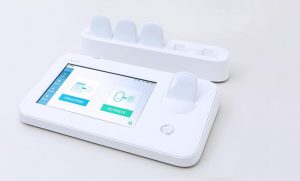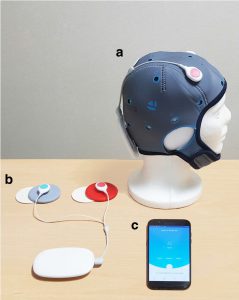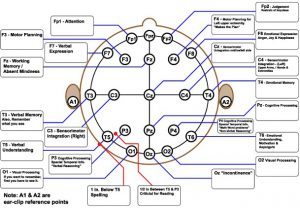tDCS (Transcranial Direct Current Stimulation)
การรักษาด้วย เครื่องกระตุ้น ผ่านไฟฟ้ากระแสตรงในผู้ป่วยหลอดเลือดสมอง
tDCS หรือ Transcranial Direct Current Stimulation เป็นการรักษารูปแบบหนึ่ง โดยใช้ เครื่องกระตุ้น ด้วยกระแสไฟฟ้าตรงอย่างอ่อนลงไปที่สมองส่วนที่ได้รับการบาดเจ็บ เพื่อกระตุ้นให้สมองเกิดการฟื้นตัว ซึ่งวันนี้ทาง ReBRAIN จะมาอธิบายกันว่า เครื่องกระตุ้น tDCS คืออะไร? ลักษณะของเครื่องมือ tDCS ด้วย เครื่องกระตุ้น
เป็นยังไง กลไกการทำงานของเครื่อง ข้อห้าม ข้อควรระวังในการรักษาด้วยวิธีนี้ และการรักษานี้ควรทำควบคู่กับการรักษาทางกายภาพบำบัดหรือไม่
Transcranial Direct Current Stimulation หรือชื่อย่อที่เรียกง่ายๆว่า เครื่องกระตุ้น tDCS (ทีดีซีเอส) เป็นรูปแบบการรักษารูปแบบหนึ่ง ใช้การกระตุ้นโดยปล่อยไฟฟ้ากระแสตรงอย่างอ่อน กระตุ้นไปยังบริเวณสมองส่วนที่ได้รับบาดเจ็บ ให้สมองเกิดการฟื้นตัวขึ้นมา
โดยลักษณะของเครื่องมือประกอบด้วย 4 ส่วนคือ
1.ขั้วกระตุ้น 2 ขั้ว คือ ขั้วบวกและขั้วลบ โดยขั้วทั้งสองตัวจะปล่อยกระแสไฟฟ้าในลักษณะไฟฟ้ากระแสตรงวิ่งระหว่างขั้วทั้งสอง โดยจะมีฟองน้ำชุบไว้ที่ขั้ว เพื่อป้องกันไม่ให้เกิดการกระคายเคืองขณะกระตุ้น
2. เครื่องกระตุ้น ปล่อยกระแสไฟฟ้าขนาดเล็ก จะติดไว้กับขั้วกระตุ้น คอยปล่อยกระแสไฟฟ้าออกมา
3.หมวก โดยหมวกดังกล่าวจะมีรูไว้สำหรับวางตำแหน่งขั้วกระตุ้น ซึ่งตำแหน่งดังกล่าวจะอ้างอิงกับตำแหน่งต่างๆของสมอง แต่ละตำแหน่งที่กระตุ้นจะได้ผลการรักษาที่แตกต่างกันด้วย
4.ตัวเครื่องควบคุมหลักสำหรับการตั้งค่าในการปล่อยกระแสไฟฟ้าสำหรับสั่งการเครื่องขนาดเล็ก

ตัวเครื่องหลัก (อันใหญ่) และตัวเครื่องปล่อยกระแสไฟฟ้า (อันเล็ก)

ขั้วกระตุ้น (ขั้วบวก/ลบ) และหมวก เครื่องบางรุ่นสามารถสั่งการจากมือถือได้

รูปภาพที่ 3 : แผนผังของสมองสำหรับการวางตำแหน่งขั้วกระตุ้น (จุด CZ คือจุดที่วางขั้วกระตุ้นหลัก)
กลไกการทำงานของเครื่องมือการรักษา จะเริ่มจากผู้ทำการรักษาจะต้องหาจุดที่วางขั้วกระตุ้นหลัก (ส่วนใหญ่จะวางบริเวณกึ่งกลางศีรษะ ตามรูปภาพที่ 3) โดยใช้การวัดด้วยสายวัดในการหาตำแหน่ง หลังจากนั้นจะวางขั้วกระตุ้นขั้วหนึ่งในจุดกึ่งกลางศีรษะ อีกขั้วหนึ่งจะวางไว้ในจุดที่ต้องการจะกระตุ้น หลังจากนั้นจะเริ่มตั้งค่าการกระตุ้นกระแสไฟฟ้าที่เครื่องควบคุมหลักให้ปล่อยกระแสไปยังเครื่องกระตุ้น การรักษาจะปล่อยกระแสไฟฟ้ากระแสตรงขนาด 0.5 – 2 มิลลิแอมแปร์ ใช้ระยะเวลาการรักษา 10 – 40 นาที จากงานวิจัยของ ภารดีและคณะ(1) เชื่อว่า
กลไกการทำงานของเครื่องทีดีซีเอสขณะทำการกระตุ้นด้วยกระแสไฟฟ้ากระแสตรงจะไปปรับเปลี่ยนความต่างศักย์กระแสไฟฟ้าของเซลล์ประสาทในระยะพักของสมองให้ทำงานได้ดีขึ้น และกระตุ้นให้กระแสประสาทในสมองทำงานได้เร็วขึ้น ส่วนใหญ่การรักษาด้วยเครื่องมือนี้จะรักษาในผู้ป่วยหลอดเลือดสมองเป็นหลัก และคนไข้ที่มีพยาธิสภาพของโรคที่สมอง เช่น อัลไซเมอร์ พาร์กินสัน เป็นต้น
หลายๆท่านอ่านมาถึงตรงนี้คงสงสัยกันว่า รูปแบบการทำงานของเครื่อง tDCS คล้ายๆกับการทำงานของเครื่อง TMS ที่ใช้กระตุ้นการฟื้นตัวของสมองหรือเปล่า?
โดยความแตกต่างของ tDCS และ TMS ที่สำคัญคือ tDCS จะไปกระตุ้นปรับเปลี่ยนการทำงานของกระแสประสาทในสมองให้ตอบสนองได้เร็วขึ้นและดีขึ้น ส่วน TMS จะไปกระตุ้นตัวเซลล์ประสาททำให้เกิดความเปลี่ยนแปลงที่ตัวเซลล์ประสาท ทำให้ขณะทำการรักษาจะเห็นการเคลื่อนไหวของกล้ามเนื้อขณะกระตุ้นด้วย นอกจากนี้ผลข้างเคียงหลังจากการรักษานั้น tDCS จะมีผลข้างเคียงน้อยกว่า TMS ด้วย และตัวเครื่องกระตุ้นของ tDCS สามารถนำกลับไปกระตุ้นที่บ้านได้
สำหรับข้อห้ามและข้อควรระวังในการรักษาด้วย tDCS คือ
1.จะไม่ทำการรักษาในคนไข้ที่กำลังตั้งครรภ์
2. คนไข้ฝังเครื่องกระตุ้นไฟฟ้าหัวใจไว้
3. คนไข้ที่มีโรคที่ลุกลามได้ เช่น มะเร็ง
4. คนไข้พึ่งได้รับการบาดเจ็บที่สมอง
5. คนไข้ที่มีภาวะปวดศีรษะ มีไข้ ก่อนทำการรักษา
การรักษาด้วย tDCS นอกจากจะช่วยกระตุ้นให้สมองได้รับการฟื้นฟูแล้วควรทำการรักษาควบคู่กับการทำกายภาพบำบัดด้วย โดยกล่าวถึงงานวิจัยของ Víctor Navarro-López และคณะ ทำการศึกษาโดยทำการรักษาด้วย tDCS ควบคู่กับการทำกายภาพบำบัดในผู้ป่วยหลอดเลือดสมอง จำนวน 222 คน พบว่า หลังจากทำการรักษาควบคู่กันแล้ว คนไข้มีพัฒนาการในเรื่องของการเดิน จังหวะการก้าวเดิน การทรงตัวของคนไข้มีประสิทธิภาพดีขึ้น จากงานวิจัยของ wan-wen Liao และคณะได้ทำการศึกษาเกี่ยวกับการกระตุ้นด้วยเครื่อง tDCS ร่วมกับการรักษาทางกายภาพบำบัดด้วยวิธีการออกกำลังกายตามภาพในกระจก (Mirror Therapy)
ในคนไข้หลอดเลือดสมองระยะเรื้อรัง จำนวน 3 กลุ่ม แบ่งเป็น
กลุ่มที่หนึ่งกระตุ้นด้วย tDCS ร่วมกับทำกายภาพบำบัดพร้อมกัน
กลุ่มที่สอง กระตุ้นด้วย tDCS แล้วค่อยทำกายภาพบำบัดตามหลัง
กลุ่มที่สามไม่ได้กระตุ้น tDCS (กระตุ้นหลอก) ร่วมกับทำกายภาพบำบัด ทำครั้งละ 90 นาที 5 วันต่อสัปดาห์ ในระยะเวลา 1 เดือน พบว่า กลุ่มที่หนึ่งให้ผลการรักษาได้ดีกว่าทั้งสองกลุ่ม
สำหรับการรักษาด้วย tDCS ในประเทศไทย ยังไม่เป็นที่แพร่หลายและ tDCS ยังอยู่ในขั้นตอนของการวิจัยและศึกษาอยู่ ซึ่งสุดท้ายแล้วในอนาคตการรักษาด้วยเครื่องมือดังกล่าว คงจะมีให้เห็นมากขึ้นในการรักษาคนไข้หลอดเลือดสมอง เนื่องจากความสะดวกสบายของอุปกรณ์การรักษาที่สามารถนำเครื่องกลับไปกระตุ้นที่บ้านได้ ผลข้างเคียงของเครื่องมือที่ใช้ในการรักษาน้อย รวมถึงสามารถทำการรักษาควบคู่กับการทำกายภาพบำบัดและผลการรักษาดีมีประสิทธิภาพด้วย
tDCS (Transcranial Direct Current Stimulation)
tDCS, or Transcranial Direct Current Stimulation, is a form of treatment. It uses a weak direct current stimulation to the injured part of the brain. to stimulate the brain to recover Today, ReBRAIN will explain what tDCS is? What is the nature of the tDCS instrument, its mechanism of action, contraindications and precautions for this method?
And should this treatment be done in conjunction with physical therapy treatment?
Transcranial Direct Current Stimulation, commonly abbreviated tDCS (TDCS), is a form of treatment. Use a weak direct current stimulation. Stimulates the injured area of the brain allow the brain to recover By the nature of the tool consists of 4 parts:
1. There are two excitation terminals, the positive terminal and the negative terminal. The two terminals will release electricity in the manner of direct current running between the two terminals. There will be a sponge moistened at the terminal. To prevent irritation during stimulation
2. Small electric generator will be attached to the excitation terminal keep releasing electricity
3. Cap. The cap has a hole for positioning the excitation pole. which the position is referring to the different locations of the brain Each stimulating location will also have different treatment results.
4. The main control unit for setting the discharge power for operating the small machine.
The mechanism of action of the therapeutic tool Starting from the treatment person must find the point where the main stimulation electrode is placed. (Most are placed in the center of the head as shown in Figure 3) by using a tape measure to find the position.
After that, one of the excitation electrodes is placed in the center of the head. Another pole is placed where it needs to be stimulated. After that, it will start to set the excitation current at the master regulator to release current to the exciter.
The treatment emits a DC current of 0.5 – 2 milliamperes, the duration of treatment is 10-40 minutes. Paradee et al.(1) believe that the mechanism of action of the TDCS during direct current stimulation modifies the voltage difference of neurons in the resting phase of the brain to work better. and stimulate the nerve impulses in the brain to work faster Most of the time,
treatment with this tool is primarily used for patients with cerebrovascular accidents.
and patients with pathologies of brain diseases such as Alzheimer’s, Parkinson’s, etc.
Many of you who have read up to here are probably wondering that. Is the tDCS function similar to that of the TMS machine that stimulates brain recovery? The main difference between tDCS and TMS is that tDCS stimulates and modifies the activity of nerve impulses in the brain to respond faster and better, while TMS stimulates neurons, causing changes in the neurons.
Contraindications and precautions to treatment with tDCS are:
1. Will not treat patients who are pregnant.
2. The patient is implanted with a pacemaker.
3. Patients with invasive diseases such as cancer
4. The patient recently suffered a traumatic brain injury.
5. Patients with headache and fever before treatment
เอกสารอ้างอิง
1.Auvichayapat P, Auvichayapat N. Basic knowledge of transcranial direct current stimulation. Journal of the Medical Association of Thailand = Chotmaihet thangphaet. 2011;94(4):518-27.2.Liao WW, Chiang WC, Lin KC, Wu CY, Liu CT, Hsieh YW, et al. Timing-dependent effects of transcranial direct current stimulation with mirror therapy on daily function and motor control in chronic stroke: a randomized controlled pilot study. Journal of neuroengineering and rehabilitation. 2020;17(1):101.
3.Navarro-Lopez V, Molina-Rueda F, Jimenez-Jimenez S, Alguacil-Diego IM, Carratala-Tejada M. Effects of Transcranial Direct Current Stimulation Combined with Physiotherapy on Gait Pattern, Balance, and Functionality in Stroke Patients. A Systematic Review. Diagnostics. 2021;11(4).
4.Park J, Oh Y, Chung K, Kim KJ, Kim CO, Park JY. Effect of home-based transcranial direct current stimulation (tDCS) on cognitive function in patients with mild cognitive impairment: a study protocol for a randomized, double-blind, cross-over study. Trials. 2019;20(1):278.